| In the previous issue I suggested that,
before seeking out harp guitar instruction materials, prospective harp
guitarists should first be thinking about what type of instrument,
music, or playing style they hope to pursue.
For the moment, we’ll continue on as if you (the
prospective player) already have or are planning to purchase a
“standard” 6-bass instrument – perhaps a Dyer-style instrument,
perhaps a double-neck or other form.
Using this particular harp guitar as our sample, I’ll now
address the Instructional Resources listed in the last issue: Instruction Books,
DVDs, Videos, and Repertoire: Music and Tab.
Unfortunately, at this moment in “harp guitar
time,” this will be more of a discussion of what’s not
available (and why) than what is.
|
| Instruction Books: There are none to speak of.
I did sell a reproduction of an early tutor that covered the “bass-guitar”
and “lute.” The
former is simply a Viennese double-neck harp guitar, the latter the same
thing with a lute body (the correct term being basslaute).
The nominal tuning for 6
basses happens to be F-G-A-B(Bb)-C-D –the
same standard tuning I introduced last issue.
There are then options for 3 to 7 bass strings. Some
simple illustrations are included, along with exercises and
many songs. I sold
several reprints (I have one left), but I have no idea how useful they
were, as the book is clearly geared to the beginning guitarist/musician
who has zero knowledge of the fingerboard or basic music theory.
I have copied the original early 1900’s version and recently
made it available to Harpguitars.net members here.
If nothing else, it is an interesting historical document.
Assuming that most beginning harp
guitarists are proficient, or at least educated, guitarists, these guitar
rudiments are unnecessary (and Wobersin’s fretting with the thumb may
give some players pause). Players
with no prior experience would be just as well off using any of the
hundreds of great methods for standard 6-string guitar, and dealing with
the floating basses a bit later on.
I have a heard a couple of the
top players mention this subject from time, so perhaps we might one day
see a harp guitar instruction book of some kind. |
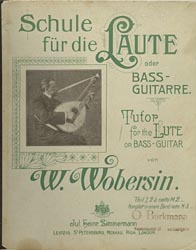
|
|
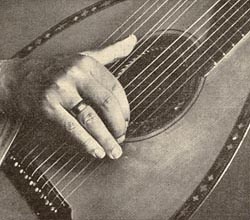
The extent of Wobersin’s examples of sub-bass technique.
|

Wobersin notates sub-basses with an “8” – meaning, play the written
note an octave lower on the appropriate bass string.
Here he shows two enharmonic scales, with the first sub-bass (D)
tuned up to become D# / Eb.
|
|
Instructional DVDs: There are none yet that I know of, but as we
speak, TrueFire is preparing a harp guitar training DVD series
with Stephen Bennett. This
may be the first such detailed teaching aid ever created and should
prove highly valuable, if I know both Truefire and Stephen.
Of course, SB will be using his sub-bass tuning and demonstrating
his own particular techniques and style, with musical compositions and
arrangements from his own vast repertoire.
So if you’re a Bennett fan, this will be a godsend.
If you’re into other music, I expect you would still find much
value in Stephen’s shared instruction and experience.
|
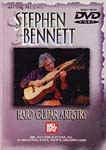 |
Videos: While waiting for Truefire’s first Bennett release, I
would certainly recommend watching any of the performance DVDs
available. While the artists
may not be giving specific instruction, or using a dedicated 2-camera
(each hand) shoot, seeing and hearing a performance can be worth a
thousand words. There are
good DVDs by Stephen Bennett, along with harp guitar performances in
DVDs by Muriel Anderson and John Doan. |
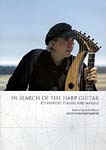
|
|
Showing an increase in quality, a growing number of
videos of all manner of artists, from Michael Hedges to Andy Mckee to
the stable of Holloway Harp Guitar artists, are showing up on YouTube.
Long ago, we even started a YouTube Harp Guitar
Group so that people could easily find all the videos in one spot.
It soon grew beyond anyone’s ability to add every appropriate
clip to it (let alone organize, or judge or control any quality), so
I’m afraid you’ll have to mostly search on your own, and see what
appeals to you. The main
thing to take away from all these video clips is how the different
players are using the bass strings, including techniques of thumb
position, striking, plucking, damping, harmonics, etc.
Take advantage of the free clips and absorb all you can.
Here again, I’ve found that most prospective harp guitarists
have been introduced to the instrument by a particular favorite musician
– either at a live show, or via YouTube.
But before trying to duplicate your favorite hero’s tunes,
I’d recommend listening to as many players as you can; you never know
when a new favorite might be discovered.
Always remember that some players may use significantly different
tunings and techniques, if not instruments.
With videos, just like with audio recordings, we
also start getting into other types of music and harp guitars besides
the modern Dyer-style players. Along
with more complex modern harp guitars like John Doan’s 20-string
instrument with super-trebles and many other modern configurations,
including a variety with nylon strings, you can see and hear a growing
number of performances of historical music on period or reproduction
instruments. For example,
you can find Bach transcribed onto a variety of different harp guitars,
and you can hear some of the typical 10-string music of mid-1800’s
composers like Mertz (who used a common form of Viennese harp guitar
with 4 floating basses). For
a look at the harp guitar’s accompaniment role, you might search “kontragitarre”
or “Schrammelgitarre” to see how the instrument has been
utilized in Austria and Germany non-stop for well over a century.
Finally, you might discover a truly rare “time
capsule” video of an authentic historical harp guitarist, such as
Eddie Peabody flat-picking his Gibson Style U, or the mighty Taraffo
himself (on this site).
I mention all these seemingly unrelated musical
options because all are examples of genuine “harp guitar music” and,
in fact, all have been investigated and asked about by one person or
another during the recent harp guitar resurgence.
So, just as I brought up in Part 1 - what kind of harp guitar and
harp guitar music are you hoping to play?
The sky’s the limit!
|
| Repertoire: Music: A
common question inevitably asked during any historical harp guitar
presentation is “What kind of music was originally played?”
Or more specifically, “Is there any repertoire and/or published
repertoire?” As you can
probably guess by now, the answer is different for each type of
instrument, period, or culture that developed the particular harp guitar
in question. |
| Starting (arbitrarily) with historical European
repertoire, we’re fortunate to have access to preserved 78 recordings
of Italian virtuosos like Pasquale Taraffo, Luigi Mozzani, and Mario
Maccaferri. None of these
recordings have yet been transcribed, however, nor published in the form
of the original harp guitar arrangement.
Similarly, while there was a plethora of 7-, 8-, 9- and 10-string
“harp guitarists” performing and composing from the early to mid
1800’s, few of their arrangements were published as they played them.
Instead, the pieces were transcribed for the common 6-string
guitar, the instrument played by the composer’s students and the
public. Amongst scholars,
some of the original multi-bass music has been collected and shared
(we’ll be seeing a fine example at the Gathering
this November), while other original performances are extrapolated, by
transposing the suitable bass notes.
What about all those endless 7, 9 or 11-bass kontragitarres?
As mentioned above, these were rarely used as solo instruments,
but served the role of a “portable piano” in the original Schrammel
Quartet and the “Schrammelmusik”
that followed. Nearly every
small to large ensemble had (and still has) one playing an accompaniment
to the Viennese waltzes and other traditional music popular to this day.
These historical players (and likely the modern ones as well)
learned or developed their thumb techniques and bass line patterns
locally, not from any written music.
|
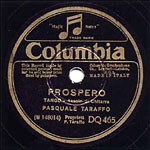 |
 |
| Well then, surely in
historical America, land of the ubiquitous harp guitar, there is much
written and published harp guitar music?
Sorry – once again, it is virtually nonexistent.
The reason again is simply that the harp guitar was used as an
accompaniment instrument for the most part. And even when many of these
accompaniment parts were written out and published as part of the
mandolin orchestra repertoire – often listed as “Guitar or Harp
Guitar Accompaniment” – what the player would get would be simple
standard 6-string music. It
was expected that the harp guitarists would simply drop the bass an
octave as desired. With the
much rarer harp guitar soloists, the same concept applied. |
 |
In all my research of early American music periodicals, I have so far
only found music by two harp guitar soloists.
The first, Walter Boehm, was the well known
multi-instrumentalist/teacher who created the Gibson 10-sub-bass tuning
system. The other is an
otherwise unknown and forgotten player named John Witter, who in 1918
advertised for some time the "Book of Solos" written for the harp guitar.
As the ad boasts, it
was indeed the "only one of its kind
published." This complete
folio, along with an example of Boehm’s harp guitar music, is
available for study on the Members Section of this
site. I suspect that few
modern players will find it all that exiting - it is representative of
the light (but “serious”) parlor music popular in the early part of
the 20th century. Though
both Boehm and Witter specifically played, and wrote for, the Gibson
harp guitar with 10 chromatic basses, the music (as they state) can be
played on most any harp guitar, as only a couple of sub-bass notes are
used in any given piece. One
could play it today on almost any harp guitar.

Witter notates the
sub-basses with an “8”- meaning, play the written note an octave
lower on the appropriate bass string. |
And finally we reach contemporary harp guitar
music, in all its many styles. The
“classical guitar” world has its repertoire, so how about the harp
guitar? Ah, but they are a
multitude, and we are few. They
are also able to draw on composers and pieces from uninterrupted
centuries of guitar music, including all manner of modern 20th
century composers. And
we’re really just getting warmed up.
But we are establishing
a repertoire. From Michael
Hedges and Stephen Bennett to more recent harp guitar converts like
Jason Carter and Philippe Fouquet, we are seeing an ever-increasing body
of harp guitar work. Most of
the recordings are easily obtainable, but what about written music?
Well, the news isn’t all bad.
True, the harp guitar world has been off to a slow start in this
regard – understandably, as the students have only recently started to
appear, and still in small numbers.
As written music for modern steel-string guitar has, of course,
evolved, let’s start a new heading:
|
|
Repertoire: Tablature:
In most cases, both standard music notation and
harp guitar tablature are included – though the systems may differ.
As discussed in Tablature on this
site, there are several ways to notate the sub-bass strings, so
individual performers may choose different methods.
Arguably the most famous modern harp guitar piece,
“Because It’s There” by Michael Hedges was also the first to be
written out accurately in tab form.
John Stropes (Stropes Editions)
worked directly with Hedges to capture and notate the many unusual
techniques. Note that
Hedges created his own custom, non-linear tuning for his 5 subs (see
information on his original Dyer here), so care
should be taken to string
the instrument properly (a set of light strings for 5-bass Standard
Tuning may work okay, though some players of Hedges’ harp guitar music keep
a second Dyer specifically strung for his repertoire).
|
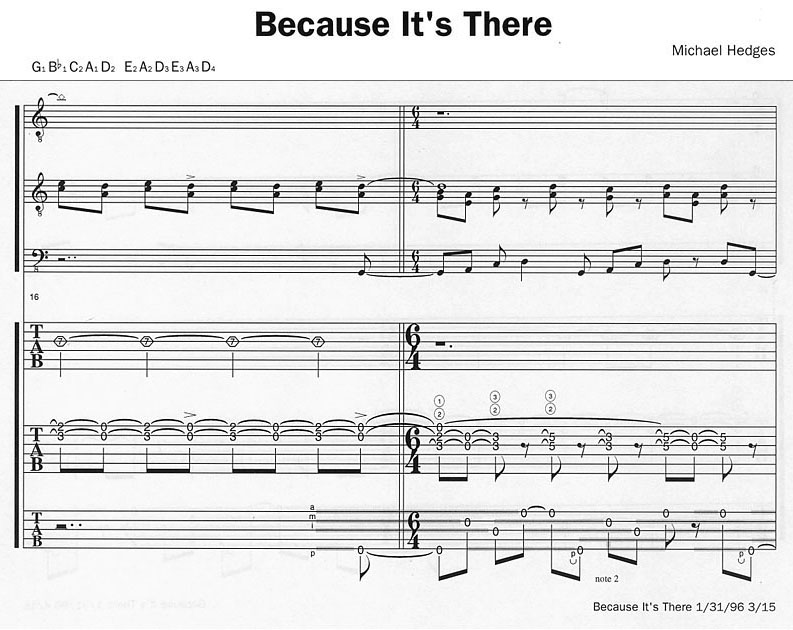 |
Stropes shows tuning (low>high) at the top, and notates the
sub-basses with a "0" on each separate bass string line. (The
middle staves are reserved solely for left hand tapping-only notes)
He created an ingenious and valuable new technique
specifically for the complex muting Hedges executes on the famous
sub-bass melody (the gray bars denote exactly when the right-hand
fingers and thumb are touching the strings).
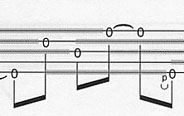
It's an amazing accomplishment to have captured and
archived this piece at all, let alone so accurately.
|
Additional Hedges tab may be downloaded from
Rootwitch.com.
At the time of this writing, only Double Planet was available.
|
 |
Sample from Michael Hedges’ “Double
Planet.”
Site owner Jim
Roosa created his own form of tab (no standard notation), with sub-bass
notes written below the appropriate neck markings. Tuning is provided at the top.
Players will presumably be familiar with the song and timing. |
“Overnight sensation” Andy Mckee has produced tab for
several of his harp guitar tunes, available by download from his web
site.
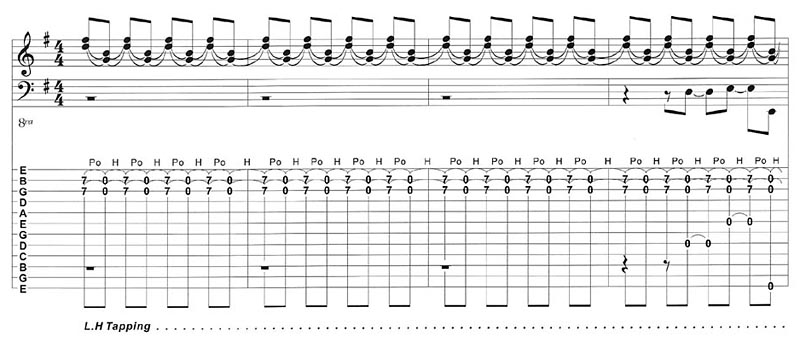
|
Sample
from Andy McKee’s “The Friend I Never Met.”
Tuning is given at start of tab.
Subs are notated on their own stave, and for the tab, given their
own string.
While the
“0”s may seem redundant, this system is useful for showing
complicated sub-bass harmonics, and an easy visual system for players
unaccustomed to the specific tuning.
Note that unlike other harp
guitar tab, there is no separation between string banks, so it
might not be the easiest TAB to sight read. |
| Ever-popular Stephen Bennett has published
tab for two of his most requested original pieces (Perestroika
and Sea Rose
Beach) and also his full traditional album Good Wood.
These are all available from Harp Guitar Music
as individual or bulk PDFs. |
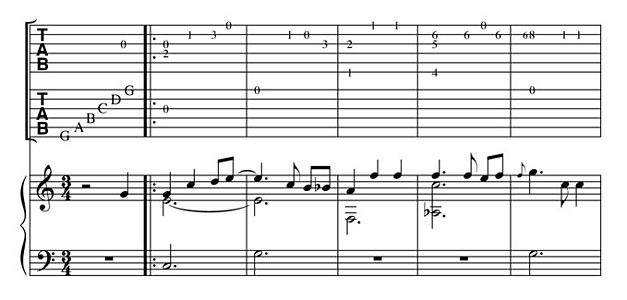 |
Sample from Stephen
Bennett’s arrangement of “Home on the Range.”
The neck tuning is standard, while
the sub-bass tuning is provided at the start (in this case they are
standard Bennett tuning).
Like McKee’s, the subs are denoted
with “0” (open) on their individual lines.
In this piece, the Tab appears
above the Notation (SB has done it both ways). |
|
Most harp guitar players don’t tab out their
music (I’m one of the few, as I’d otherwise forget my own tunes!)
– they simply play it, so have no need notation, until enough fans
request it. Wouldn’t you
love to see an Andy Wahlberg “Standards” folio?
Why not ask him? Or
Muriel Anderson, who has written several harp guitar pieces.
With enough demand, the task may become economically feasible,
and some of these players will then be able to offer their arrangements.
Have faith – the world of harp guitar music and
resources continues to grow by leaps and bounds!
Next
Issue: The subject
of Teachers and Classes…plus Super-Trebles and beyond. |
About the Author
|
